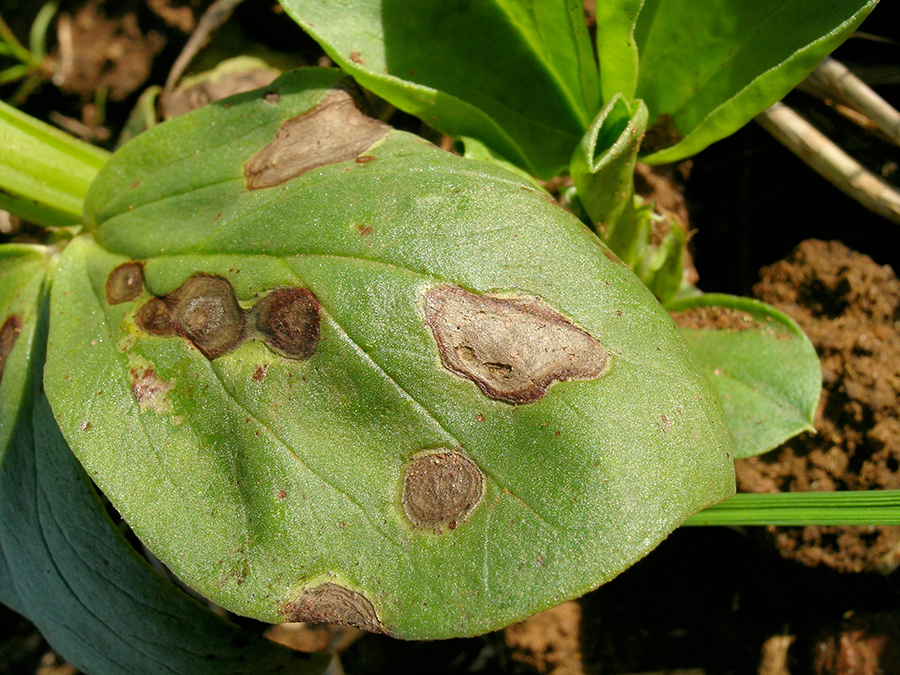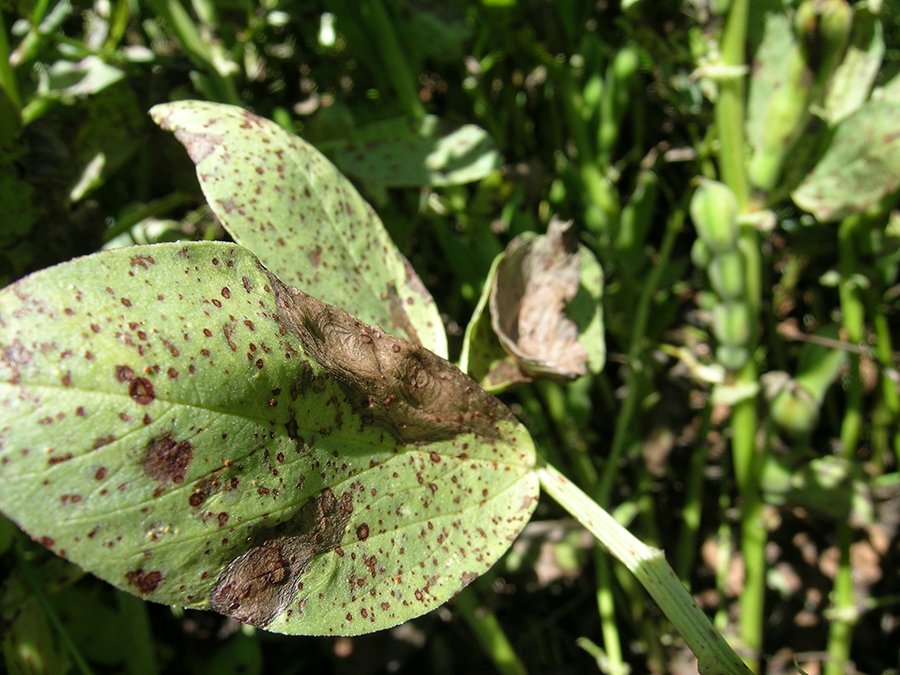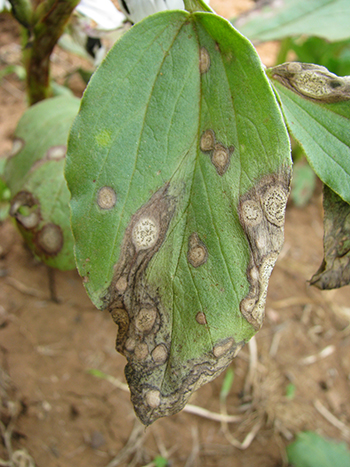Australia
July 16, 2024
- Sow disease-resistant faba bean varieties
- Start disease management as early as possible
- Use integrated disease management
A plant pathology expert says disease management is integral to growing high-quality faba beans.
NSW Department of Primary Industries plant pathologist Dr Kurt Lindbeck told growers that disease management must be taken seriously when growing faba beans.
These were his opening remarks at a GRDC–Brill Ag faba bean workshop held in March at Ganmain, NSW.
“Grade-one faba beans for human consumption are what you need to target,” he said.
“In overseas markets, buyers run their hands through open bags of faba beans looking for a clean product, with good seed colour and size, and that’s where the premium is found.”
He said to ensure you know the disease resistance level of your faba bean variety and the most important disease in your area.
“Varieties vary greatly in their levels of disease resistance, and knowing the most important disease risk will help with fungicide management decisions.”
Fungicide timing
Regarding disease protection, he said the timing of fungicide application was critical.
“Ninety per cent of doing an effective job with fungicides is applying them at the right time,” he said.
“Another part of achieving a disease-free crop is following the sowing time and the varieties recommended for your district.”
Dr Lindbeck recommended that growers avoid producing large, bulky faba bean crops where possible. Large and bulky crops would be a challenge for managing disease at the start of August.
“Sow seeds into soils free from constraints such as waterlogging and low pHCa, while supplying adequate nutrition,” he said.
“Faba beans also need the correct rhizobia (new Group F) to ensure the crop forms nodules on its roots to fix nitrogen from the atmosphere.
“An unstressed crop with everything it needs is less likely to succumb to disease.”
Disease identification
Correct disease identification was critical for disease management, he said. Distinguishing between chocolate spot, Ascochyta blight and Cercospora could be difficult.
 Cercospora spot lesions with concentric rings on faba bean leaves. Photo: Rohan Kimber, SARDI Plant Pathology
Cercospora spot lesions with concentric rings on faba bean leaves. Photo: Rohan Kimber, SARDI Plant Pathology
If unsure, he suggested using the internet to check faba bean growing guides or contacting him to discuss disease symptoms.
Growers should start disease management as early as possible, which involved paddock and variety choice and early fungicide applications.
Where possible, he encouraged the use of integrated disease management and not relying on fungicides alone, as they were not a silver bullet.
Dr Lindbeck recommended aiming for economic disease control, not complete disease eradication. This involved monitoring crops at least once weekly and returning to the same point in each paddock.
“Check for spots on the lower leaves and determine if they are increasing in size or moving higher in the canopy. Take weekly photos and compare them.”
If unsure, send photos showing symptoms via email to assist with disease identification.
Diseases of risk
 Chocolate spot lesions on faba bean leaves. Photo: Rohan Kimber, SARDI Plant Pathology
Chocolate spot lesions on faba bean leaves. Photo: Rohan Kimber, SARDI Plant Pathology
Chocolate spot was the main disease of faba beans, he said. Other less-frequent diseases included rust and Cercospora.
“If you are a first-time faba bean grower, PBA Amberley is a good variety to grow because it is moderately resistant (MR) to moderately susceptible (MS) to chocolate spot,” he said.

Ascochyta blight lesions with pycnidia. Photo: Rohan Kimber, SARDI Plant Pathology
“The MR-MS rating allows more time to respond to disease because the pathogen’s progression in PBA Amberley is slower than in other varieties.”
He confirmed Sclerotinia was not a major disease of faba beans because fungicides used against chocolate spot were also effective against Sclerotinia.
“Faba beans are the least-susceptible pulse crop to Sclerotinia. The canopy architecture doesn’t lend itself to disease expression.”
Nonetheless, he said, faba beans could host Sclerotinia and contribute to the pathogen’s survival between seasons.
Critical periods
The first critical period for fungicide application in faba beans was six to eight weeks after emergence (Figure 1). At this stage, fungicides were mainly deployed to manage Ascochyta blight and Cercospora.

The second critical period for fungicide application was just before canopy closure, he said. This targets chocolate spot and Ascochyta blight, if present.
“The application of a foliar fungicide just before canopy closure allows full penetration of the crop canopy with fungicide, targeting potential infection sites that are low in the crop canopy. This will put the crop in a good position moving into spring.
“If the canopy is about to close and the lower leaves have chocolate spot, check whether the next seven to 14 days will be wet. If this is the case, apply fungicide at label rates.”
The third critical period for fungicide application protects the seed from infection from late flowering to early podding and against disease infection of the pods and seeds.
Fungicide products
Fungicides varied in the period of protection offered, he said. “Older chemistries offer 10 to 14 days of protection, whereas new generation fungicides increase this period to four to six weeks.
“Even after fungicide application, crops should still be monitored every seven to 10 days to ensure that fungicides are effective.”
Follow the label
As a human consumption product, Dr Lindbeck said strict limits applied to fungicide residues detected in faba beans. “Always follow the recommended label rates and timings of fungicide product application.
Some of the newer fungicides, in particular, have restrictions on the crop growth stage and timing of application.”
WHAT IS INTEGRATED DISEASE MANAGEMENT?
NSW Department of Primary Industries plant pathologist Dr Kurt Lindbeck says integrated disease management for faba beans involves:
- planting faba beans 500 metres away from old faba bean and vetch stubbles;
- managing self-sown faba beans or vetch over summer;
- sowing seed free of disease;
- adhering to the recommended sowing date, rate and depth, which will affect the canopy size and disease risk;
- using foliar fungicides; and
- harvesting faba beans as soon as they are ripe (14 per cent moisture). The more rain that falls on faba beans after maturity, the more likely seed staining and downgrading will occur.
More information: Kurt Lindbeck, kurt.lindbeck@dpi.nsw.gov.au
Resources